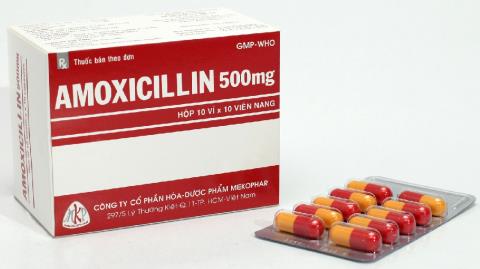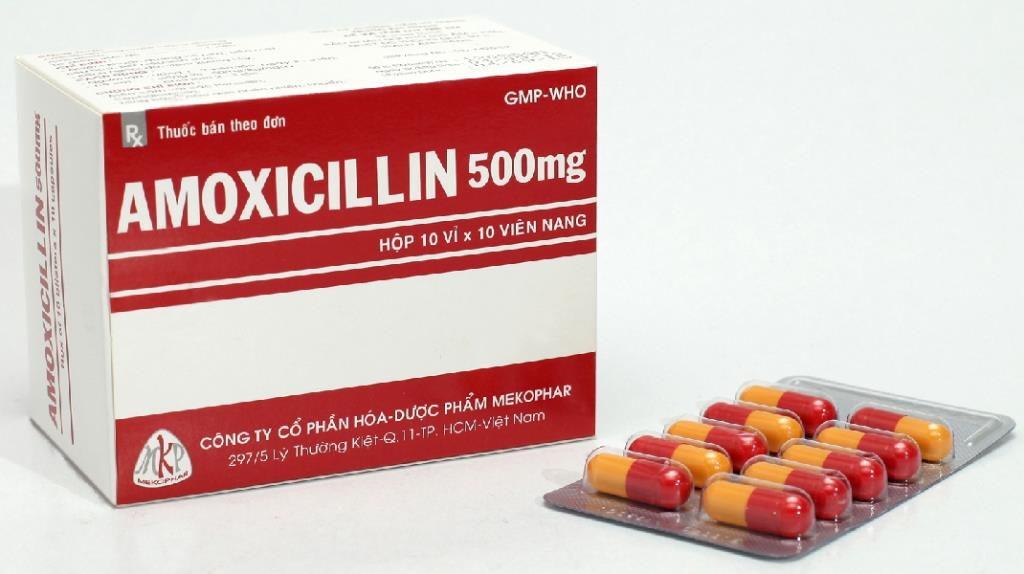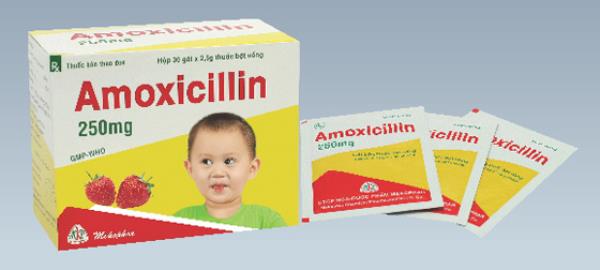Amoxicillin antibiotic: Uses, uses and precautions

What is Amoxicillin? What is Amoxicillin used for? What disease does Amoxicillin treat? What should be noted about possible side effects while taking the drug? Let's learn more about Amoxicillin with SignsSymptomsList in the article analyzed below!
Active ingredient : Amoxicillin.
Drugs with similar active ingredients : Amomid; Amoxclo; Amoxfap; Amoxico-500; Amoxipen; Amoxividi 250; Amoxmarksans; Amoxy; Amoxybiotics; Ardimox 250; Droplie; Etonxy; Eumoxin; Fabamox; Franmoxy; Hadomox;…
content
- What is Amoxicillin antibiotic?
- Price of Amoxicillin
- What does amoxicillin do?
- How to use the antibiotic Amoxicillin effectively?
- Dosage of amoxicillin
- Side effects of medications
- Interactions that occur when taking the antibiotic Amoxicillin
- Precautions while taking the antibiotic Amoxicillin
- Special Uses
- How to store Amoxicillin antibiotics?
What is Amoxicillin antibiotic?
Drug form and strength
Amoxicillin is a form of antibiotic. This Amoxicillin only works against certain types of bacteria, but does not kill viruses. Oral forms of amoxicillin are trihydrate. The injection uses the sodium salt form of amoxicillin. The drug content is calculated as anhydrous amoxicillin.
The drug is manufactured by Domesco company (Vietnam).
- Capsules 250 mg, 500 mg amoxicillin.
- Tablets: 125 mg, 250 mg, 500 mg and 1 g amoxicillin.
- Powder for oral suspension: Pack of 125 mg, 250 mg of amoxicillin to make 5 ml of suspension.
- Or powder for injection: Vials of 500 mg and 1 g of amoxicillin.

Image of antibiotic Amoxicillin
Pharmacology and mechanism of action
- Amoxicillin is an aminopenicillin, stable in acidic medium, with a broader spectrum of action than benzylpenicillin. Especially effective against Gram (-) bacilli.
- Like other penicillins, amoxicillin is bactericidal. This is because the drug binds to one or more bacterial penicillin-binding proteins (PBPs) to inhibit peptidoglycan biosynthesis. Among them, PBP is an important component of the bacterial cell wall.
- The bacteria eventually degrade themselves by the autolytic enzymes of the bacterial cell wall (autolysin and murein hydrolase).
Price of Amoxicillin
The price of antibiotic Amoxicillin 500mg, box of 10 blisters x 10 tablets costs about 100,000 VND.
What does amoxicillin do?
Point
Amoxicillin 500 mg is indicated for the treatment of infections caused by susceptible bacteria:
- Upper respiratory tract infections, sinusitis, otitis media .
- In addition, treatment of lower respiratory tract infections caused by streptococci, pneumococcus, non-penicillinase-producing staphylococcus and H. influenzae.
- Uncomplicated urinary tract infections.
Besides, the drug is also indicated for the treatment of diseases:
- Gonorrhea.
- The patient has a biliary tract infection.
- Skin and muscle infections caused by streptococcus, staphylococcus, E. coli sensitive to amoxicillin.
- Lyme disease in children or pregnant or lactating women.
- Anthrax disease.
Not only that, the antibiotic amoxicillin is also indicated for the treatment of Chlamydia trachomatis infection of the urogenital tract in pregnant women who are intolerant of erythromycin (little experience).
It also treats problems with gastroenteritis (including Salmonella enteritis, not bacillus dysentery), or endocarditis (especially for prophylaxis in patients undergoing surgery or tooth extraction), or typhoid fever and paratyphoid fever.

Antibiotics Amoxicillin in combination with other drugs in the treatment of H. pylori infection in patients with peptic ulcer disease
Contraindications
People who have ever been allergic to any type of amoxicillin or to any penicillin should not take this medicine.
How to use the antibiotic Amoxicillin effectively?
Amoxicillin trihydrate is for oral use only. The sodium salt form of amoxicillin is for parenteral use only. Absorption of amoxicillin is unaffected by food in the stomach, so it can be taken before or after a meal.
With powder for suspension, when used you can mix with milk, juice, water and drink immediately after mixing.
In case of intramuscular injection: Note, not for intravenous injection of solution for intramuscular injection.
- Adults: Do not inject more than 1 g/time.
- Children: Do not inject more than 25 mg/kg/time.
- Children and children <3 years old:="" mix="" on="" 5="" ml="" water="" distilled="" to="">
Intravenous injection: Inject slowly directly intravenously over 3-4 minutes.
- Adults: Do not inject more than 1 g/time.
- Children: Do not inject more than 25 mg/kg/time.
Rapid intravenous infusion over 30-60 minutes.
- Adults: infusion < 2="" g="" amoxicillin="" one="">
- Children: infusion < 50="" mg/kg="" one="" times.="" infusion="" static="" circuit="" inter="">
Dosage of amoxicillin
1. Patients with normal kidney function
Sensitive bacterial infections of the ear, nose, throat, skin, urinary tract in adults
- Mild, moderate infections: Amoxicillin 250 mg x 3 times/day or 500 mg x 2 times/day.
- In severe infections: 500 mg x 3 times/day or 875 mg x 2 times/day.
Use Amoxicillin
- Mild and moderate infections: Amoxicillin 20 mg/kg/day x 3 times/day or 25 mg/kg/day x 2 times/day.
- For severe infections: 40 mg/kg/day, 3 times/day or 45 mg/kg/day, 3 times/day
2. Helicobacter pylori infection
Adults orally at a dose of 1 g/day orally twice a day, in combination with clarithromycin 500 mg x 2 times/day and omeprazole 20 mg x 2 times/day (or lansoprazole 30 mg x 2 times/day) x 7 days.
Then, take 20 mg of omeprazole (or 30 mg of lansoprazole) daily for another 3 weeks if duodenal ulcer is advanced, or 3 to 5 weeks if peptic ulcer is advanced.
3. Prophylaxis of infective endocarditis
Adults: A single dose of 2 g, taken 1 hour before the procedure.
The dose of Amoxicillin for children is 50 mg/kg (do not exceed the adult dose), taken 1 hour before the procedure.
4. Mild heart inflammation (1st or 2nd degree atrioventricular block)
Dosage Amoxicillin 500mg/time x 3 times/day. Adults take for 14-21 days.
Children <8 years old:="" 50="" mg/kg/day="" divided="" into="" 3="" times="" (dose="" evening="" multi="" 1.5="">
5. Arthritis, not associated with Lyme disease neurological disorder
Adults: 500 mg/time x 3 times/day x 28 days.
Children: 50 mg/kg/day in 3 divided doses (maximum 1.5 g/day).
6. Prophylaxis of infective endocarditis
Adults: 2 g IV over 30 minutes, 1 hour before the procedure.
Children: 50 mg/kg IV, 1 hour before the procedure.
For patients with renal impairment, the dose must be reduced according to the creatinine clearance:
- Clcr < 10="" ml/min:="" 250="" –="" 500="" mg/="" day="" sub="" belongs to="" on="" level="" degree="" severe="" of="" infection="">
- Clcr: 10 - 30 ml/min: 250 - 500 mg/ 12 hours depending on severity of infection.
- Severe renal failure with Clcr < 30="" ml/min="" can not="" use="" tablet="" compress="" contains="" 875="" mg="">
In addition, in hemodialysis patients: 250–500 mg/24 h depending on severity of infection and an additional dose during and after each dialysis session.

Amoxicillin antibiotic for children
Side effects of medications
Common symptoms
You may experience one or more of the following symptoms while taking this medicine:
- The rash usually appears slowly, after 7 days of treatment.
- Nausea, vomiting, epigastric pain, diarrhea in adults, the rate is higher in children and the elderly.
Uncommon reactions
- Hypersensitivity reactions: Erythema, maculopapular rash and urticaria.
- Special attention should be paid to Stevens-Johnson syndrome.
Although rare, patients can still experience the following side effects:
- Slight increase in liver enzymes.
- Agitation, restlessness, anxiety, insomnia, confusion, behavioral changes and/or dizziness.
- Pseudomembranous colitis due to C. difficile; acute pyelonephritis with abdominal pain and bloody stools, unrelated to C. difficile.
- Anemia, thrombocytopenia, thrombocytopenic purpura, eosinophilia, leukopenia, agranulocytosis.
Interactions that occur when taking the antibiotic Amoxicillin
- Nifedipine.
- Allopurinol.
- Fusidic acid, chloramphenicol, tetracycline.
- Methotrexate.
- Oral contraceptives.
- Typhoid vaccine.
- Warfarin.
- Probenecid.
Precautions while taking the antibiotic Amoxicillin
- Must periodically check hematology, liver and kidney function during long-term treatment.
- Serious hypersensitivity reactions may occur in patients with known allergy to penicillin or other allergens. Therefore, prior to initiating treatment with amoxicillin, a thorough investigation of the history of allergy to penicillins, cephalosporins and other allergens is recommended.
- Use high doses of amoxicillin for people with kidney failure or who have had a previous seizure; Seizures can cause convulsions, although they are rare.
- In case of renal failure, the dose must be adjusted according to the creatinine clearance or serum creatinine.
- Oliguria is a risk for drug crystallization. Therefore, you must drink a lot of water when taking the medicine.
- The risk of rash is high in patients with infectious mononucleosis.
- In addition, caution should be exercised in patients with phenylketonuria and phenylalanine levels should be controlled in patients taking tablets or powder for oral suspension containing aspartame, as aspartame is converted in the gastrointestinal tract to phenylalanine.
Amoxicillin overdose treatment
Manifestations of overdose include neuropsychiatric symptoms, renal (crystaluria) and gastrointestinal disturbances. You should handle an overdose as follows:
- Currently, there is no specific antidote.
- Amoxicillin can be removed by hemodialysis.
- When treating symptoms, special attention should be paid to the water-electrolyte balance.
What to do when you miss a dose of Amoxicillin?
If you miss a dose, you should:
- Use as soon as you remember that you have missed a dose.
- If the missed dose is close to the next dose. Skip the missed dose and follow the dosing schedule.
- Do not take a double dose to make up for the missed dose.
Special Uses
Pregnant women
The safety of amoxicillin in pregnancy has not been clearly established. Therefore, use this medicine only when clearly needed during pregnancy. However, there is no evidence of harmful effects on the fetus when amoxicillin is administered to a pregnant woman.
Therefore, Amoxicillin is the drug of choice for the treatment of Chlamydia infection and for the treatment of cutaneous anthrax or as a precaution after exposure to Bacillus anthracis spores in pregnant women.
Breastfeeding Women
Amoxicillin is excreted in breast milk. However, the amount of drug in milk is very small and safe for infants at commonly used doses. Therefore, amoxicillin can be used in breastfeeding women, closely monitoring young children when used.
How to store Amoxicillin antibiotics?
- Keep Amoxicillin out of reach of children and pets.
- Store the medicine in a cool, dry place. Avoid direct exposure to light or keep Amoxicillin in humid places.
- The best storage temperature is <30>
Above is information on the use of the antibiotic Amoxicillin . The use of the drug should be according to the prescription and instructions and instructions of the doctor. Therefore, you should go to the doctor to be diagnosed with the disease and prescribe the appropriate oral medication.